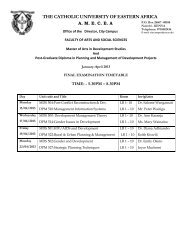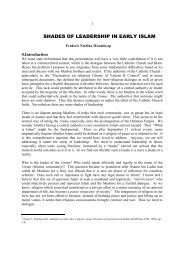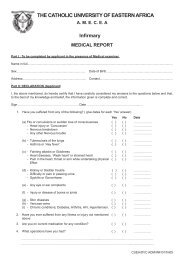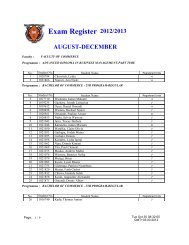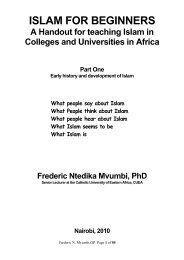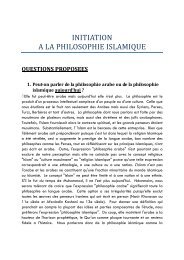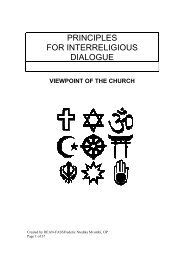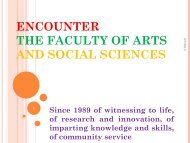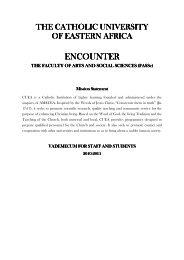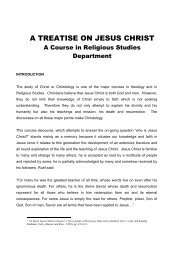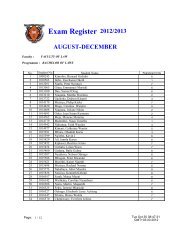58God’s essence. This teaching about ahwal, or adjectival attributes, was accepted by later Ash`aritetheologians, who also maintained a distinct existence for God’s sifat al-ma`ani, or substantialattributes.Al;-Ka`bi (d.929 or 931) was at a time leader of the Mu`tazilites of Bagdad. He tried to reduce themany names applied to God to just a few basic ones. Thus “willing” is simply a combination of“knowing” and “creating”, while “hearing” and “seeing” are just aspects of “hnowing”. In spite ofthese men’s allowing of a real disatinction among the attributes of God, the general Mu`taziliteposition was that God and his attributes are all identical, with no real distinction in him whatsoever.Those who distinguished God’s attributesOne of the earliest speculators of God’s unity was Hisham ibn-Hakam (d.805). He used the termjism, which usually means “body”, in the wider sense of susbatance and applied to God (for whichhe was criticized). He was also the first to use the term ma`na (literally “meaning”) in the technicalsense of an inseparable attribute, and in this way spoke of the attributes of God, such as powerand knowledge.Bishr al-Marisi (d.833) introduced a distinction between essential and active attributes, and amongthe latter he recognized four: will (mashi`a), knowledge (`ilm), power (qudra) and creativity (takhlid).Anthropomorphic attributes mentioned in the Qur’an he interpreted away. Ibn-Kullab (d.855) tookthis speculation a step further by positing for each adjectival attribute (sifa ma`nawiyya), such as“power” or “knowledge”, a corresponding substance attribute (sifa al-ma`na), such as” power andknowledge”. Furthermore he distinguished attributes, such as all the foregoing, which pertain toaction, and attributes which discribe God’s essence, such as “existence or eternity”.Ibn-Kullab had a student named al-Qalanisi who, using Kalam to defend these and other Sunniteteachings, brought them to the attention of al-Ash`ari, who adopted them. In the meantime ibn-Karram (d.869) in Persia tried to face the problem of relationship between the eternal and thetemporal, or the uncreated and the created. He and his followers asserted that God was Creator orcreating )khaliq) through the attribute of creativeness (kaliqiyya) evn before creation existed. Thisattribute they interpreted as a power over creation. Yet when any creature comes into being, theysaid that this requires some change (hudud) in God, which the addition of the decision and thecommand that the creature come into being. Such a position was criticized in many quarters asleading to pantheism, since it sets up a continuity of mutual dependence between God andcreatures. Al-Ash`ari accepted the ideas of various kinds of attributes in God, distinct from oneanother and from God’s essence, but he himself did not systematize his teaching with the precisionof later Ash`arites.Al-Maturidi (d.944), as noted in the previous chapter, differed from al-Ash`ari on some points. Oneof then concerns the discussion on creation. Al-Maturidi held that all attributes are eternal, whileAsh`ari and his immediate followers said that the active attributes are not eternal; for instance Godis creating only when creatures exist. A late exponent of Ash`arite theology who had been veryinfluential in North and West Africa is Muhammad ibn-Yusuf as-sanusi (d.1490). Inhis umm albarahimor small catechism, he lists what has become a standard list of 20 attributes:Among what is necessary to our Lord -the majestic and mighty- are twenty attributes. These are:1) existence (wujud), 2) being from eternity 3) being everlasting 4) otherness from thing that come
59into being, 5)self-subsistence, that is, he does not need a subject-of-inherence nor a determiningagency, 6) oneness, that is, there is no duplication of his essence, attributes or acts. The first ofthese six attributes, existence, pertains to the essence itself (nafsiyya), whereas the other five arenegative attributes (salbiyya). Then the most high necessarly possesses seven attributes calledsubstantive attributes (sifat al-ma`ani). They are 7)power and 8) will, which are related to allpossible things, 10) life, which is related to nothing, 11) hearing and 12) sight, which are rekated toall existing things, and 13) speech, which is without letters or sound, and is related to the samethings knowledge is related to.The most High necessarily possesses seven attributes called adjectival attributes (sifatma`nawiyya). They follow upon the first seven, and are the most high’s being: 14)powerful, 15willing, 16) knowing, 17) living, 18) hearing, 19) seeing, 20) speaking.The first part is conceived and written by Frederic Ntedika Mvumbi, OpThe second part is a revised course (revised by Frederic Ntedika) taught by Joseph Kenny, O.PProfessor of Islamic studiesUniversity of IbadanNigeria



